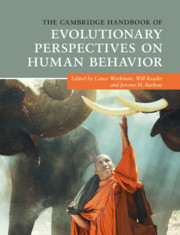Book contents
- The Cambridge Handbook of Evolutionary Perspectives on Human Behavior
- The Cambridge Handbook of Evolutionary Perspectives on Human Behavior
- Copyright page
- Dedication
- Contents
- Figures
- Tables
- Contributors
- Preface
- Acknowledgments
- Part I The Comparative Approach
- Part II Sociocultural Anthropology and Evolution
- Part III Evolution and Neuroscience
- Part IV Group Living
- Part V Evolution and Cognition
- Part VI Evolution and Development
- 21 Evolutionary Developmental Psychology
- 22 The Ontogeny and Evolution of Cooperation
- 23 Genomic Imprinting Is Critical for Understanding the Development and Adaptive Design of Psychological Mechanisms in Humans and Other Animals
- 24 Evolutionary Explanations for Bullying Behavior
- 25 Birth Order and Evolutionary Psychology
- Part VII Sexual Selection and Human Sex Differences
- Part VIII Abnormal Behavior and Evolutionary Psychopathology
- Part IX Applying Evolutionary Principles
- Part X Evolution and the Media
- Index
- References
22 - The Ontogeny and Evolution of Cooperation
from Part VI - Evolution and Development
Published online by Cambridge University Press: 02 March 2020
- The Cambridge Handbook of Evolutionary Perspectives on Human Behavior
- The Cambridge Handbook of Evolutionary Perspectives on Human Behavior
- Copyright page
- Dedication
- Contents
- Figures
- Tables
- Contributors
- Preface
- Acknowledgments
- Part I The Comparative Approach
- Part II Sociocultural Anthropology and Evolution
- Part III Evolution and Neuroscience
- Part IV Group Living
- Part V Evolution and Cognition
- Part VI Evolution and Development
- 21 Evolutionary Developmental Psychology
- 22 The Ontogeny and Evolution of Cooperation
- 23 Genomic Imprinting Is Critical for Understanding the Development and Adaptive Design of Psychological Mechanisms in Humans and Other Animals
- 24 Evolutionary Explanations for Bullying Behavior
- 25 Birth Order and Evolutionary Psychology
- Part VII Sexual Selection and Human Sex Differences
- Part VIII Abnormal Behavior and Evolutionary Psychopathology
- Part IX Applying Evolutionary Principles
- Part X Evolution and the Media
- Index
- References
Summary
Striking examples of human cooperation include people donating blood, paying their taxes, and helping total strangers on the street. These are acts of altruistic cooperation – behaviors that benefit the collective at a cost to the individual. To many researchers, explaining altruistic behaviors is central to understanding human cooperative uniqueness (Fehr & Fischbacher, 2003; Gintis et al., 2005), with the central question being how the fruits of cooperation can be enjoyed without being exploited by individuals who free-ride on the benevolent actions of others while not contributing themselves. Over recent decades, substantial advances have been made in identifying the factors that sustain cooperation in this context (Camerer, 2011; Hammerstein, 2003; Milinski, Semmann, & Krambeck, 2002). Here, we take a different approach and argue that an equally fundamental challenge of cooperation is for individuals to coordinate their behavior in order to generate mutual benefits (the “forgotten problem of cooperation”.
- Type
- Chapter
- Information
- Publisher: Cambridge University PressPrint publication year: 2020
References
- 1
- Cited by



